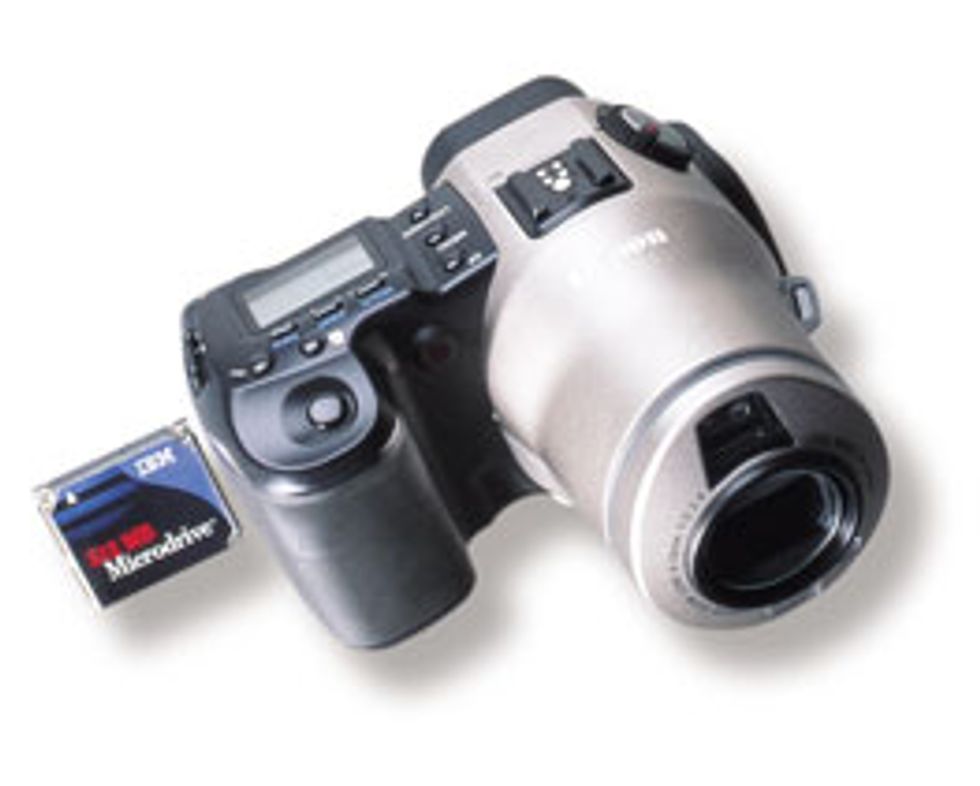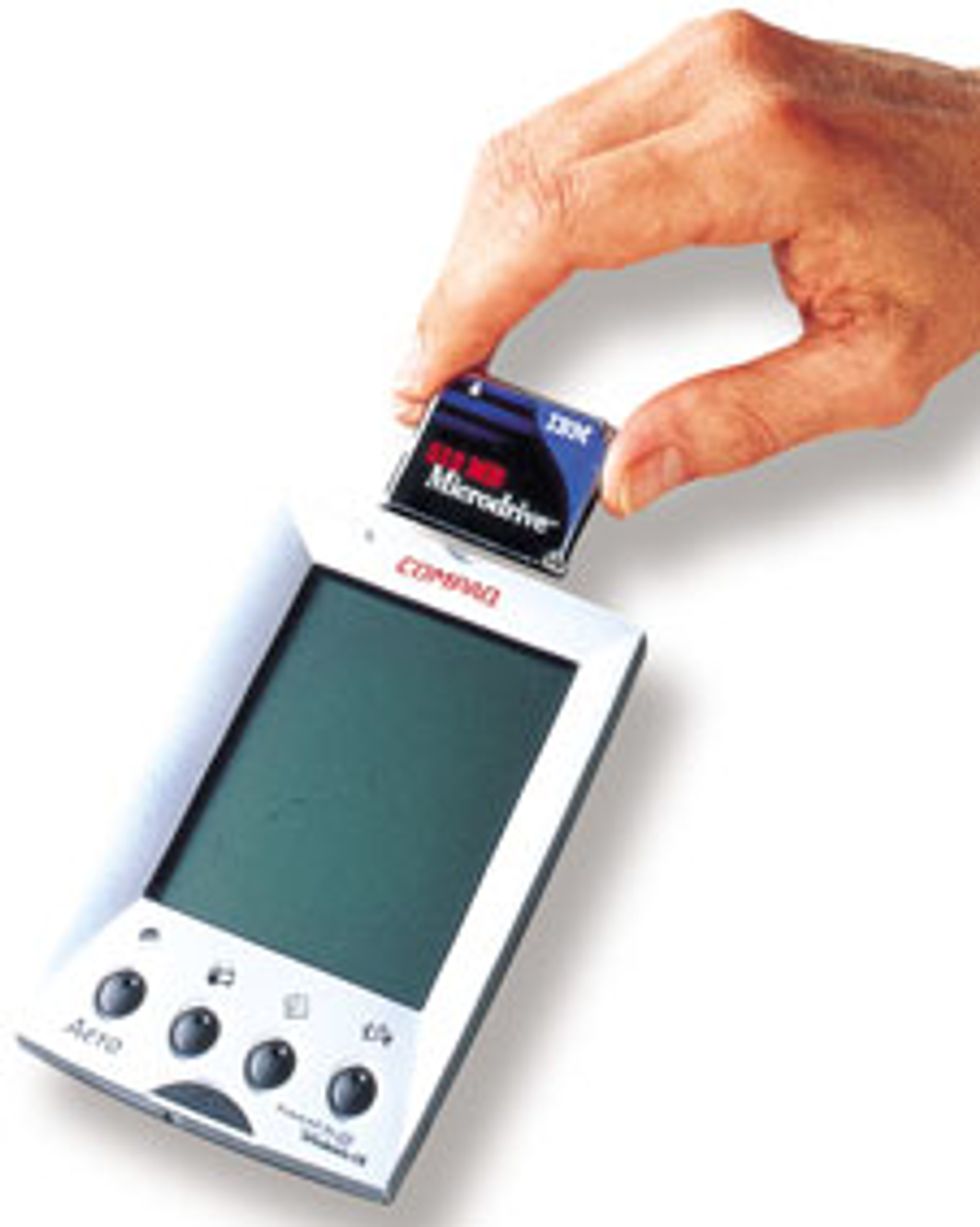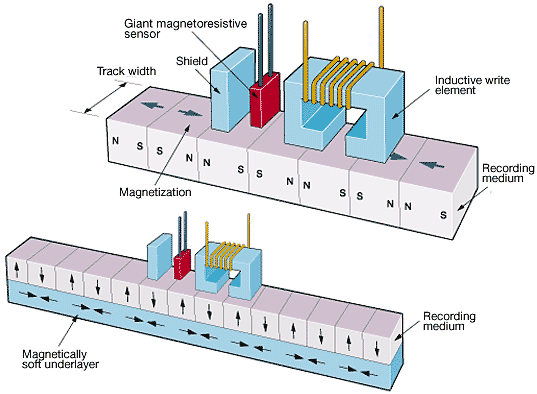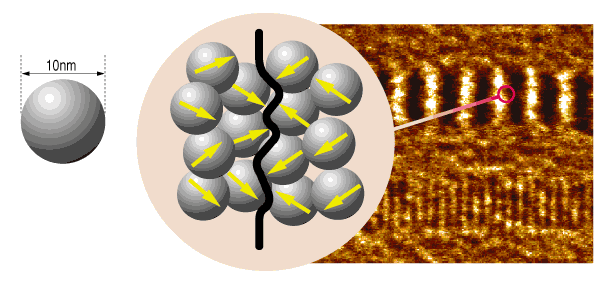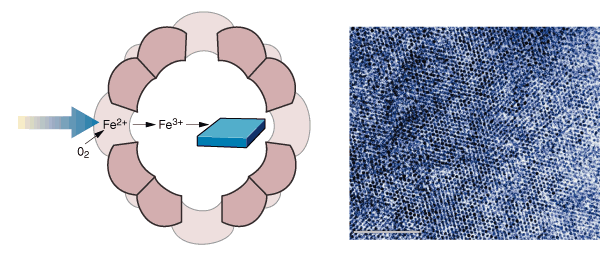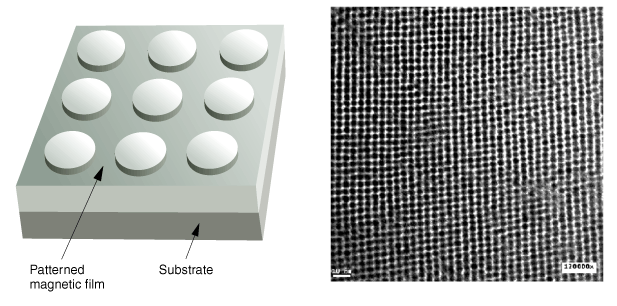Magnetic Storage: The Medium That Wouldn't Die
Researchers stuff more and more bits into each square centimeter of space on a magnetic disk, keeping it king of mass data storage
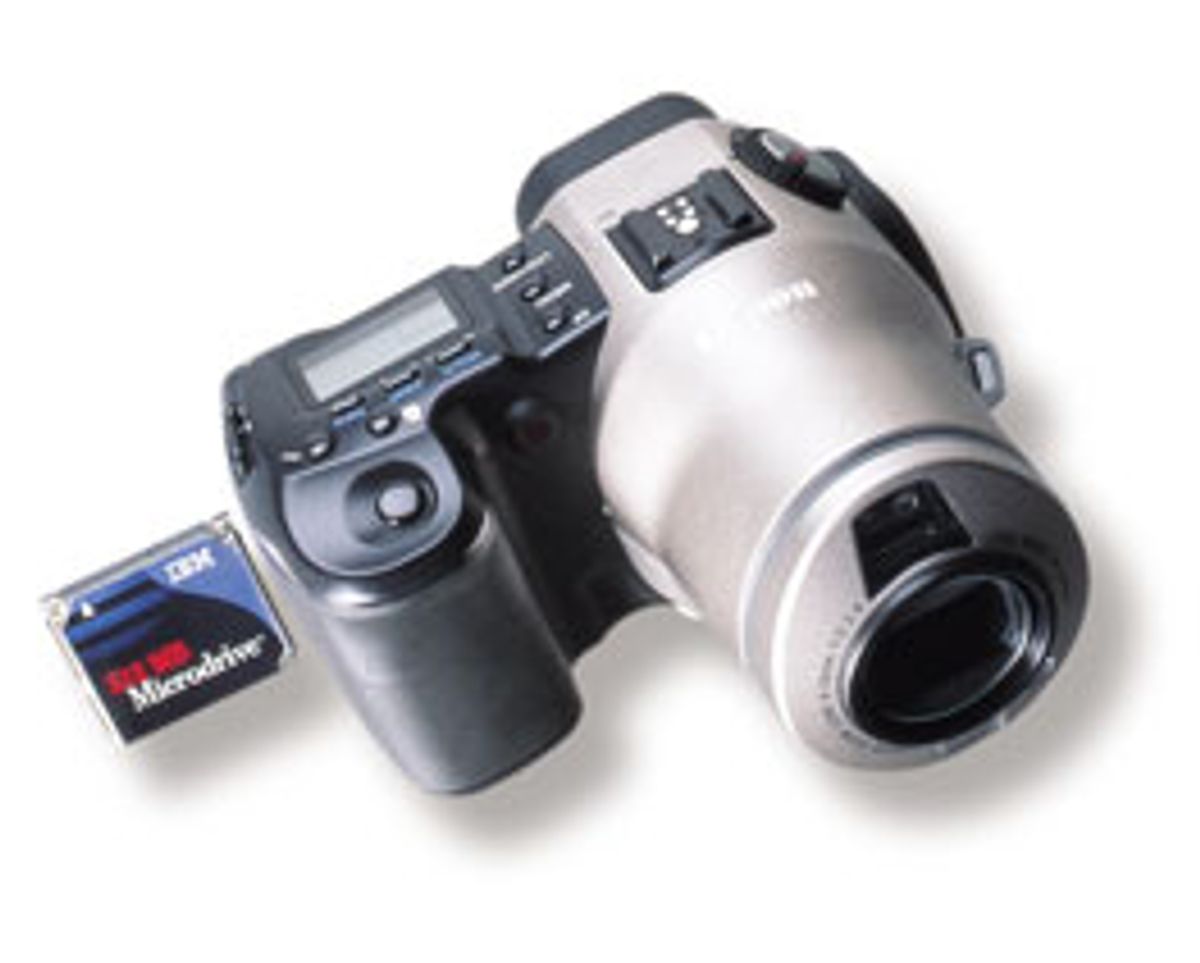
Never before has the number of bits that can be crammed onto each square centimeter of magnetic disk risen so far so fast. Last April, magnetic storage researchers working in a laboratory at Fujitsu Ltd., in Tokyo, announced they could pack magnetic disks with 8.7 gigabits per square centimeter. In so doing, they bested IBM Corp.'s record of 5.4 Gb/cm2, set just seven months before. For its part, when IBM had announced its record high in October 1999, it was overturning its own previous May high of 3.1 Gb/cm2. For a technology that has been around since 1956, a 180 percent increase in bit density in the course of one year was, well, impressive.
Instead of slowing with age, magnetic hard disk technology has sped up. Starting in 1997 with IBM's introduction of the first giant magnetoresistive read-and-write head, density has been doubling every year. Semiconductor memory, in contrast, still obeys Moore's Law, taking 18 months to double in density. Researchers now expect disk storage density to continue doubling at least until the middle of this decade. Noting this trend, David Thompson, director of the advanced magnetic recording laboratory at IBM's Almaden Research Center in San Jose, Calif., declared, "There are no alternative technologies that can dislodge magnetic recording from its present market niche in the next 10 years."
This is not the first time magnetic disk technology has proven more durable than the storage community expected. Since 1977, engineers have been making predictions about how much data could ultimately be crammed into a given disk area, and time after time those ceilings have been broken. Although engineers still see challenges to bringing Fujitsu's latest laboratory advances to market, the consensus is that magnetic storage capacity will continue growing.
Fujitsu's feat does more than speed disk progress--it revises a six-year-old view of magnetic technology's potential bounds. A phenomenon called the superparamagnetic effect predicts that, once some minimum size is reached by the metal grains used to hold a magnetic field (indicating by its polarity the presence of a 1 or 0 bit on a disk), the grains will demagnetize spontaneously at room temperature.
At just what grain size this will occur is still under investigation, but it appears to be on the order of 10 nm or so. Since the minuteness of the grains ultimately determines how much data can be packed into a given area, determining the disk's maximum areal density, as predicted by the superparamagnetic effect, is an inexact task. It was widely believed that, at densities around 6 Gb/cm2, the grains storing the bits would be so small that thermal effects would cause them to erase spontaneously in no time at all.
To prevent this degradation, Fujitsu uses a new two-layer scheme for the recording surface, and asserts this will eventually permit densities of 50 Gb/cm2—eight times higher than was commonly thought possible. The company plans to prove the validity of its technology by delivering a commercial drive in the first half of 2001.
A drive with a single 95-mm-diameter disk, the size used in PCs, could hold 78 GB using Fujitsu's currently demonstrated technology. But both Fujitsu and IBM have another goal in mind. They are targeting the latest generation of small, portable electronic devices. This past summer, IBM delivered its new 1-GB Microdrives--whose 27-mm disk has an areal density of 2.4 Gb/cm2--to manufacturers of small personal digital assistants and digital cameras [see photos to the right]. Fujitsu's new drive will probably be close in size to the 36-by-43-by-5-mm Microdrive and could conceivably offer capacity equal to a DVD's 4.7 GB.
Keeping the market
Such an increase is needed if manufacturers are to retain their lucrative market in magnetic drives, which are the storage workhorses of the computer industry and command the lion's share of the memory market. According to James N. Porter, president of the market research firm Disk/Trend, Mountain View, Calif., worldwide sales of disk drives in 1999 reached a high of US $32 billion. Dataquest, the information technology market research arm of Gartner Group Inc., Stamford, Conn., claims that sales of dynamic RAM chips brought in only $23.1 billion the same year.
Naturally, so large a market piques the appetite of entrepreneurs who would like to replace magnetics with new technological approaches of their own. However, trying to compete head-on against hard drives has repeatedly proven a dicey proposition. Ask those who once suggested that magneto-optical disks would replace magnetic disks.
TeraStor Corp., for one, set up shop in San Jose, Calif., in 1995, to develop a technology called near-field recording, which combined magnetic and optical storage. Initial prototypes achieved densities of only a few megabits per square centimeter.
But research conducted by AT&T Bell Laboratories, Holmdel, N.J., in 1992 had shown that near-field recording would be unaffected by the superparamagnetic effect, and TeraStor projected that its technology could reach a density of about 30 Gb/cm2. Near-field recording would be "a break-through technology...delivering a sustainable tenfold capacity advantage [over] all existing storage technologies," claimed one of the company's founders, industry veteran Gordon Knight. When the superparamagnetic effect made conventional magnetic storage run out of steam, near-field recording would be its logical successor.
TeraStor had hoped to offer 20-GB, 130-mm-disk drives commercially by 1997. But the manufacturing the new components proved difficult. By mid-1998, the company had backed off from its original goal, now promising to sample a 10-GB, 130-mm-disk drive by year-end. But companies like Seagate Technology Inc., Scotts Valley, Calif., and Quantum Corp., Milpitas, Calif., were already delivering conventional 12-GB 130-mm-disk drives to PC manufacturers. This year, with its window of opportunity closed by advances in standard disk density, TeraStor shut its doors permanently.
"It's very hard for a competitor, a new technology, to come in and hit a target that is changing at 100 percent a year," IEEE Spectrum was told by Bill Higgins, an advanced development engineer for Quantum (which initially invested in TeraStor). Not only does performance improve at that rate, but so does pricing. In the last few years, while capacity doubled, the cost per megabyte has been cut in half, according to Disk/Trends, and today stands at about US $0.01/MB.
Breaking limits
In 1995, though, TeraStor's gamble seemed reasonable. It did look as if magnetic media really would hit a wall at a density one-quarter to one-half of what near-field media could attain--until this year, when Fujitsu found a way around the superparamagnetic effect by changing the disk's structure.
Today's magnetic disks consist of a substrate onto which a single layer of magnetic material is sputtered to form a recording layer [Fig.1,]. Fujitsu employs a cobalt-ruthenium-cobalt underlayer, dubbed a synthetic ferrimagnetic (SFM) structure, that couples with the conventional recording layer above it. The coupling is said to increase the stability of the recording layer's magnetic field and prevent spontaneous data loss, but there is as yet no clear consensus among researchers about how this process works.
Fujitsu found that adding an underlayer to reinforce the magnetization of the bits allows the bit domains to be narrower [bottom]. Also, still greater bit densities are possible if the material is magnetized vertically [bottom, again]. Eventually, Fujitsu thinks, this could boost density eight times to 50 Gb/cm 2. Click on image to enlarge.
Fujitsu believes that it can store up to 50 Gb/cm2 using this approach, and says it will employ perpendicular recording [Fig. 1,], a technique others are exploring. "It's an active area of investigation in the industry," said Steven Lambert, director of advanced head/media technology for Quantum, which merged with disk-drive competitor Maxtor Corp., its neighbor in Milpitas, in October. His company, with unnamed partners, is developing perpendicular techniques, too.
Lambert points out that, strictly speaking, the idea is not new: "Perpendicular recording has been a popular topic for research for at least a decade, and there has been a lot of enthusiasm about it." But he observes that it has never shipped in a hard drive, because more conventional improvements, such as better magnetic materials, have overcome past limits. "With the challenge now of the superparamagnetic limit, perpendicular recording offers some advantages in extending recording technology."
Other challenges
Just boosting the bit count on a disk is not enough to produce a better drive. For one thing, shrinking the area also cuts the strength of the magnetic field it can hold [Fig. 2]. So the read head has to be more sensitive to detect the lesser field. Fortunately, the introduction of the giant magnetoresistive head by IBM in 1997 was a great leap forward, and researchers are finding new ways to adapt it to sensing smaller bits. [See "A head of its time" ]
A bit may have hundreds of grains, each with an appropriate polarity to indicate a 1 or 0, as can be seen at the boundary [black line, above center] between a 1 and 0 bit. New technologies boost bit density by reducing the number of grains needed. Click on image to enlarge.
Since the data takes up less space, the tracks it is stored in can be narrower and closer together. For the most part, today's tracks are only 1 µm wide, with 0.5-µm tracks just starting to appear. To bring its improved density to market, Fujitsu is planning products with 1.6 tracks per micrometer, thereby pushing the track width below 0.5 µm.
This development makes it essential to position the read head with great accuracy. Any unintentional movement of the disk itself--caused by disk vibration, or jitter, as opposed to shock--can cause the read head to lose its place and misread data.
To prevent this, IBM, Fujitsu, Quantum, and others are turning to glass substrates, because they are more rigid than today's aluminum-substrate disks without adding much weight. Quantum is also adding to the number of position signals given off on each rotation of the disk. "We get more information about where the head is more frequently, which allows us to control its position better," Quantum's Lambert explained. Then, too, simply making the disks smaller cuts down on vibration, so 27-mm disks like the ones in IBM's Microdrives are likely to proliferate.
Waiting in the wings
For all that they see a future for magnetic disks, industry leaders and researchers are still experimenting with possible replacements. Among them are organically grown magnetic thin films and patterned media.
NanoMagnetics Ltd., Bath, UK, a spinoff of the University of Bristol, in Bristol, grows magnetic thin films--literally. It utilizes a protein called ferritin as a reaction vessel, after removing its core chemically [Fig. 3]. Then magnetic material of uniform size is grown within the protein.
The researchers say they can produce grains as small as 8 nm in diameter, which is less than half the size of a minimum grain today; when the technology is fully developed, the films could store as much as 700 Gb/cm2. They believe it could replace conventional magnetic films on disks.
The idea behind another new approach, called patterned media, is to create a regular array of isolated magnetic islands, each consisting of a single metal grain [Fig. 4]. As noted earlier, bits today are composed of several hundred to a thousand grains. Shrinking their number increases areal density. By using a single grain, researchers at Stanford University and IBM hope to produce stable bits as small as 50 nm.
IBM is also studying the use of the atomic force microscope to sense extremely small bits, and storing data in the form of a holograph cube, in which different information is stored in planes at different depths. But whether such exotic technologies will ever become necessary is hard to tell. As IBM's Thompson has noted, "Past attempts to predict the ultimate limits for magnetic recording have been dismal failures."
To Probe Further
Magnetic Recording: The First 100 Years, edited by Eric D. Daniel, C. Denis Mee, and Mark H. Clark (IEEE Press, Piscataway, N.J., 1998) gives a broad overview of the development of magnetic media. For a thorough technical explanation of magnetic recording, see Magnetic Hysteresis by Edward Della Torre (also IEEE Press, 1999).
For the limits of magnetic recording see https://www.almaden.ibm.com/st/projects/limits/. Details on the superparamagnetic effect appear in "Thermal Stability of Recorded Information at High Densities," by Stanley H. Charap, Pu-Ling Lu, and Yanjun He, IEEE Transactions on Magnetics, Vol. 33, 1997, pp. 978-83.
Magnetic storage will be in the spotlight next month in San Antonio, Texas, at the Eighth Joint Magnetism and Magnetic Materials Conference, also known as Intermag. For more information, contact Courtesy Associates, 2000 L St., N.W., Suite 710, Washington, DC 20036; phone, +1 202 973 8668; fax, +1 202 973 8722; e-mail: magnetism@courtesyassoc.com.
For more on the work at Cambridge University in the UK on advanced magnetoresistive heads, visit https://www-dmg.msm.cam.ac.uk/dmg/research/magneticareas.html.
